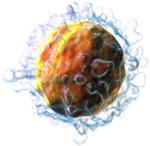immunology wars
may your immune system defend you
T-Lymphocytes

T-lymphocytes originate in the bone marrow and mature in the thymus. T-lymphocytes circulate in the blood and lymph system, they may also be found in tissues. They recognise antigens through a unique surface receptor called the T Cell Receptor (TCR).
T-lymphocytes promote an immune response when they recognise an antigen that is presented by another cell such as a dendritic cell, macrophage or other body cells that has become infected. T-lymphocytes randomly bind to antigens presented by these cells until they encounter the antigen they specifically respond to. Once this happens a process called clonal expansion occurs, with the originally activated T-lymphocyte producing multiple copies of itself, known as clones. These clones circulate throughout the body looking for signs of infection or inflammation and carry out a range of different roles within the immune response.

Source: Blausen Medical (CC)
Some T-lymphocytes (CD4+) help B-lymphocytes produce antibodies to neutralise a threat, while others (CD8+) can directly kill cells that have become infected or cancerous. Regulatory T-lymphocytes play an important role in preventing the body's immune response from attacking itself. Th17 lymphocytes play an important role in the defence against fungal infections.
Cells
- Basophils
- Eosinophils
- Mast Cells
- Neutrophils
- Monocytes / Macrophages
- Natural Killer Cells
- Dendritic Cells
- B-Lymphocytes
- T-Lymphocytes
- CD4+ T-Lymphocytes
- CD8+ T-Lymphocytes
- Regulatory T-lymphocytes
- Th17 Lymphocytes
